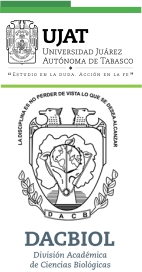FRESHWATER ROTIFER: (PART I) IMPORTANCE, LARVI FOOD, AND CULTURE
DOI:
https://doi.org/10.19136/kuxulkab.a18n34.248Resumen
in finfish larval rearing often depends on the production of phytoplankton as well as zooplankton. Phytoplankton serve as feed for the zooplankton which, in turn, nourish the fish larvae. Different size and types of zooplankton may be raised for different larval stages. Feed production at all stages must be consistent in quality and quantity for the duration of the hatchery cycle if larval rearing is to be successful. We investigated native freshwater rorifer Brachionus angularis, B. quadridentatus brevispinus, and. B. durgae where the last one is reported as a rare an uncommon species in the world which have been collected in Tabasco. The report of freshwater rotifer from Tabasco is divided in two parts, part 1 describes freshwater rotifer from Tabasco, Mexico, as live food, and how to culture them. The second part reports on two species which have been succesfully cultivated in laboratory.Descargas
Referencias
Arimoro F.O. and P.C Ofojekwu. 2004. Some aspects of the culture, population dynamics and reproduction rates of the freshwater rotifer B. calyciflorus fed selected diets. J. Aquatic. Sci., 19(2): 95-98
Arimoro, F.O. 2006. Culture of freshwater rotifer, Brachionus cayciflorus and is application in fish larviculture technology. Afr. J. Biotechnol., 5(7):536-541
Bold, H.C. and M.J Wynne. 1985. Introduction to the algae: Structure and Reproduction. 2nd ed. Prentice-Hall, Inc., Englewood Cliffs, NJ. 722 p.
Dahril, T. 1997. A study of the freshwater rotifer Brachionus calyciflorus in Pekanbaru, Riau, Indonesia. Hydrobiologia, 358: 211-215
Hirayama K., Mariyama I. and Maeda T. 1989. Nutritional effect of freshwater freshwater Chlorella on the growth of rotifer, Brachionus plicatilis. Hydrobiologia ,186/187: 39-42
Hoff, F.H. and T.W Snell. 1999. Plankton Culture Manual. Ed. Jeffery Neslen. Fifth Edition. Florida Aqua Farms, Inc., 160 p.
Indy, J.R., W.M. Contreras-Sanchez., S. Paramo-Delgadillo., L. Arias-Rodriguez., C.A Alvarez-Gonzalez., U. Hernandez-Vidal and A. McDonal-Vera. 2008. A preliminary report of two native freshwater rotifers from Tabasco, Mexico. Semana de Divulgacion y Video Cientifico, 293-297
Indy, J.R., H. Segers, L. Arias-Rodriguez, S. Paramo-Deldagillo, C.A Alvarez-Gonzalez, U. Hernandez-Vidal, A. McDonal-Vera and W.M. Contreras-Sanchez. 2009. Salinity tolerance of two freshwater rotifers from Tabasco, Mexico. World Aquaculture Society Meeting, Veracruz, Mexico.
Lubzens, E. 1987. Raising rotifers in aquaculture (a review). IV. Rotifer symposium, Edinburg, Scotland. Hydrobiologia, 147: 245-255
Lampert, W. and U. Sommer. 1997. Limnoecology. The ecology of lakes and streams. Oxford University Press, New York, 382 p.
Ludwig, G.M and S. Lochmann. 2000. Culture of the sunshine bass, Morone chrysops X M. saxatilis fry in tanks with zooplankton croped from ponds with a drum filter. J. Appl. Aquacult., 10(2): 11-26
Ludwig, G.M. 1993. Effect of Trichlorfon, Fention, and Diflubenzuron on the zooplankton community and on the production of the reciprocal-cross hybrid stripped bass fry in the culture ponds. Aquaculture, 110: 301-319
Schluter, M. and J. Groeneweg. 1981. Mass production of freshwater rotifer and liquid wastes. The influence of some environmental factors on population of Brachionus rubens. Aquaculture, 25: 17-24
Thomson, W.T. 1989. Agricultural Chemicals, Book 1, Insecticides, Acaricades and Ovicides. Thomson Publications, Fresno, CA.
Opuszynski, K., J.V. Shireman., F.J. Aldridge and R.W Rotmann. 1984. Environmental manipulation to stimulate rotifers in fish rearing ponds. Aquaculture, 42: 343-924
Park, H.G., K.W. Lee., S.H. Cho., H.S. Kim., M.M. Jung and H. S. Kim. 2001. High density culture of the freshwater rotifer, Brachionus calyciflorus. Hydrobiologia, 446/447: 369–374
Pederson, B.H. & Hjelmeland, K. 1988. Fate of typsin and assimilation eficiency in larvl herring (Clupea harengus) following digestión of copepods. Mar. Biol., 97: 467-476
Pederson, B.H., Nilesen, E.M. & Hjelmeland, K. 1987. Variations in the content of trypsin and trypsinogen in larval herring (Clupea harengus) digesting copepod nauplii. Mar. Biol., 94: 171-181
Round, F.E. 1981. The Ecology of Algae. Cambridge University Press, New York.
Descargas
Publicado
Número
Sección
Licencia
Los autores que publiquen en Kuxulkab' aceptan las siguientes condiciones como política de acceso abierto:
1. Que conservan los derechos de autor y ceden a la revista el derecho de la primera publicación, con el trabajo registrado con la licencia de atribucion de "Creative Commons", que permite a terceros utilizar lo publicado siempre que mencionen la autoría del trabajo y a la primera publicación en esta revista.
2. El autor puede realizar otros acuerdos contractuales independientes o adicionales para la distribución no exclusiva de la versión del artículo publicado en esta revista, como por ejemplo incluirlo en un repositorio institucional o publicarlo en un libro, siempre que se indique claramente que el trabajo se publicó por primera vez en esta revista.













